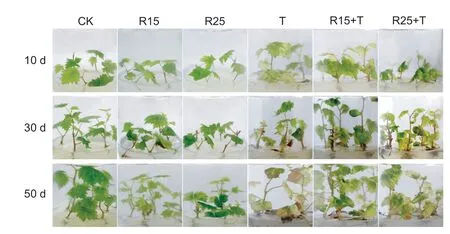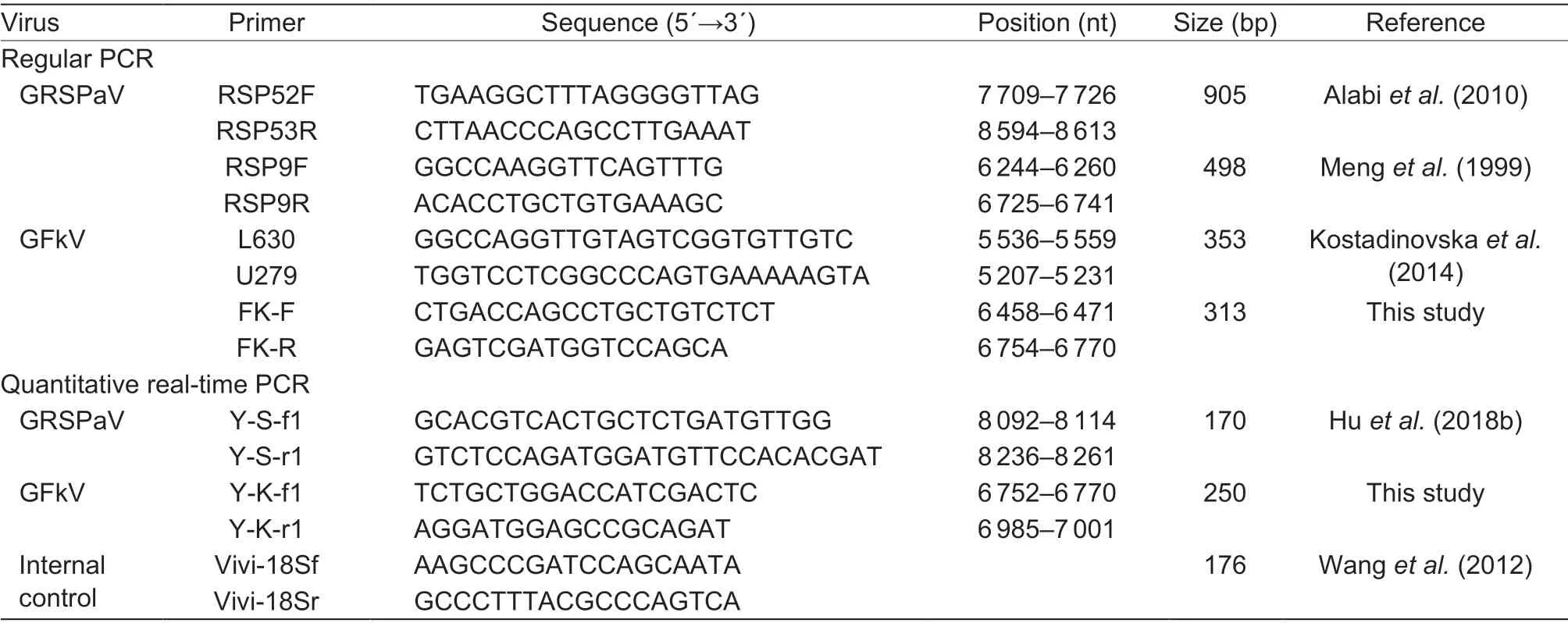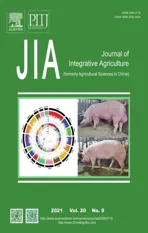Elimination of grapevine fleck virus and grapevine rupestris stem pitting-associated virus from Vitis vinifera 87-1 by ribavirin combined with thermotherapy
2021-07-24HUGuojunDONGYafengZHANGZunpingFANXudongRENFang
HU Guo-jun,DONG Ya-feng,ZHANG Zun-ping,FAN Xu-dong,REN Fang
Research Institute of Pomology,Chinese Academy of Agricultural Sciences,Xingcheng 125100,P.R.China
Abstract Vitis vinifera 87-1 plants infected by grapevine fleck virus (GFkV) and grapevine rupestris stem pitting-associated virus(GRSPaV) were used as the plant materials for virus elimination treatment.This study evaluated the effects of ribavirin at different concentrations (15 and 25 µg mL–1;R15 and R25,respectively),thermotherapy (37°C;T),and the combination of ribavirin and thermotherapy (R15+T and R25+T) on eliminating viruses from grapevine plants in vitro.Both R15 and R25 had phytotoxic effects and weakened plant growth.Thermotherapy positively affected the growth of grapevine plants.Plant height was significantly greater in T,R15+T,and R25+T than in CK,R15 and R25.The proportion of dead plants after T,R15+T,and R25+T was 51.4,11.4,and 8.6%,respectively.The survival rates of regenerated plants after all treatments were>68.0%.Ribavirin concentration and treatment time were related to the regeneration of shoot tips and elimination efficiencies of the two viruses.The survival rates of plants after R15+T for 30,40,and 50 days were 97.3,90.7,and 74.4%,respectively.The elimination rates of GRSPaV from plants in the three time quantum were 55.6,84.6,and 93.8%,respectively.The elimination rate of GFkV was 23.9% higher in R25 (35/44) than in R15 (25/45),and that of GRSPaV was 7.0% higher in R25 than in R15.The combination of thermotherapy and chemotherapy was found to have a positive effect on the eradication of GFkV and GRSPaV,and R25+T for 50 days was able to completely eliminate the two viruses from in vitro grapevines.
Keywords:in vitro grapevine,grapevine fleck virus (GFkV),grapevine rupestris stem pitting-associated virus (GRSPaV),chemotherapy,thermotherapy,virus elimination
1.lntroduction
Some viruses,viroids,or phytoplasma diseases severely inhibit the growth and development of grapevines around the world,and ultimately cause considerable decreases in fruit yields (Martelli 2012).Grapevine rupestris stem pitting-associated virus (GRSPaV,genusFoveavirus,familyBetaflexiviridae) and grapevine fleck virus(GFkV,genusMaculavirus,familyTymoviridae) are ubiquitous grapevine pathogens worldwide (Martelli and Jelkmann 1998;Martelliet al.2002).GRSPaV is perhaps the most prevalent virus affecting grapevines.It is closely associated with rupestris stem pitting (Zhanget al.1998),vein necrosis disease(Morelliet al.2011),Syrah decline (Al Rwahnihet al.2009),and other grapevine disorders (Nakauneet al.2008;Lundenet al.2010).GFkV is associated with the grapevine fleck disease complex (Poojariet al.2016).This virus occurs in simple infection and in mixed infections with other more dangerous viruses (Cretazzoet al.2010) and negatively affectsin vivoandin vitropropagation,vigor,wood quality,and agronomic and oenological parameters (Guţăet al.2014).
GRSPaV and GFkV are both restricted to the phloem of grapevines and the only known means of transmission isviavegetative propagation or grafting (Martelli 1993;Meng and Gonsalves 2007).The use of healthy propagating materials is strongly advised and represents an important measure to control grapevine viruses,since there is no treatment or cure for viral diseases once they are established in the field.Previous studies have shown that it is difficult to eliminate GRSPaV fromin vitro-cultured grapevine plants by normal meristem or shoot tip culture,or by a combination of these two methods (Gribaudoet al.2006;Maliogkaet al.2009;Skiadaet al.2009;Panattoni and Triolo 2010).In previous studies,the elimination rate of GRSPaV was no more than 80.0% after treatment with 25 µg mL–1ribavirin combined with shoot tip culture for 85 days (Huet al.2018b).There are some studies on the elimination of GFkV.A large proprotation of GFkV-free plants (91%)was otained by meristem culture (Buciumeanu and Vişoiu 2000).Thermotherapy combined with tip culture could also successfully eliminate GFkV (Komínek and Jandurova 2011;Botaet al.2014).Moreover,ribavirin showed obvious inhibition on GFkV (Komíneket al.2016;Eichmeieret al.2019).In another study,GFkV was completely eliminated both from simple and mixed infections by treatment with a combination of ribavirin and oseltamivir (Guţăet al.2014).The combination of chemotherapy and thermotherapy has been used to eradicate viruses from fruit trees,and has successfully eradicated viruses fromBegoniaspp.(Vermaet al.2005),pear (Huet al.2012),apple (Huet al.2015),and rose (Chahardehiet al.2016).However,it was unknown whether this combined method would be useful for eliminating viruses from grapevines.
This study evaluated the effectiveness of ribavirin combined with thermotherapy in eliminating GRSPaV and GFkV from grapevine 87-1.The efficiency of ribavirin was analyzed at different concentrations (15 and 25 µg mL–1),with and without thermotherapy (37°C) for various durations.The efficiency of thermotherapy (37°C) alone was also analyzed.
2.Materials and methods
2.1.Plant materials
Vitis vinifera87-1 plantlets were cultured in the Research Institute of Pomology,Chinese Academy of Agricultural Sciences.The plants had been acquired byin vivothermotherapy coupled with shoot tip culture.Testing for GRSPaV,grapevine leafroll associated virus (GLRaV)–1 to–4,–9,and–13,grapevine Pinot gris virus (GPGV),GFkV,grapevine fanleaf virus (GFLV),grapevine virus A (GVA),grapevine virus B (GVB),grapevinevirus E (GVE),and grapevine berry inner necrosis virus (GBINV) by reverse transcription PCR (RT-PCR) revealed that GRSPaV and GFkV were present in the plantlets.
2.2. In vitro cultures
Plantlets of 87-1 were cultured in a modified half Murashige and Skoog (MS) medium (Huet al.2018a).All cultures were incubated in a standard growth room at 24°C under a 16-h light/8-h dark photoperiod and 2 000 lx light intensity.Viable cultures were transferred to fresh basic half-strength MS medium at 40–45 day intervals,and the presence of GRSPaV and GFkV was re-assessed by RT-PCR.
2.3.RNA extraction and cDNA synthesis
Total RNA was extracted from samples ofin vitroregenerated grapevine as described by Huet al.(2015).First-strand cDNA was synthesized with moloney murine leukemia virus (M-MLV) reverse transcriptase (Promega,Madison,WI,USA).
2.4.Standard PCR amplification
The PCR reaction system (25 µL) contained 10× PCR buffer with Mg2+,2.5 mmol L–1dNTP mix,special primers (final concentration,1 µmol L–1),5 U µL–1rTaqDNA polymerase(TaKaRa,Dalian,China),cDNA,and double-distilled water(Huet al.2018a).Two specific primer pairs were used to detect each virus (Table 1).The PCR program was as follows:94°C for 3 min;35 cycles of 94°C for 30 s,53–55°C for 30–40 s,and 72°C for 30–50 s;final extension at 72°C for 7 min.
2.5.Quantitative real-time PCR (qPCR)
Genomic DNA in above total RNA of grapevine samples was removed and the first-strand cDNA was synthesized with the RT Reagent Kit with gDNA Eraser (TaKaRa,Dalian,China).Then,qPCR analyses were conducted using SYBR®PremixEx Taq™ Tli RNaseH Plus (TaKaRa,Dalian,China) to detect GRSPaV and GFkV in regenerated grapevine plants according to the manufacturer’s instructions.The value of Ct>34 was judged to indicate GRSPaV- or GFkV-free plants depending on the values of negative and positive controls.Each sample was analyzed in triplicate.The primer pair Vivi-18Sf/r was used as the internal control (Table 1).
2.6.Virus elimination
Grapevine shoots (approximately 1.0 cm in size) were cut fromin vitrograpevine plantlets and were treated as follows:
ChemotherapyThe filter-sterilized (0.22-µm filter,Millipore,Billerica,MA,USA) antiviral reagent ribavirin (Virazole®;Sigma-Aldrich,St.Louis,MO,USA) was added after the temperature of the fresh half-strength MS media decreased to 60–70°C.The final concentrations of the antiviral reagent were 15 and 25 µg mL–1(R15 and R25,respectively).The grapevine shoots were transferred into ribavirin-contained media.All treated plantlets were cultured in the tissue room under the same conditions above for 50 days.
ThermotherapyGrapevine shoots were cultured on fresh half MS medium in the tissue room for 10 days,and then moved into a thermal chamber (photoperiod,16-h light/8-h dark) with light intensity of 2 000 lx.The temperature in the chamber was raised gradually (3–4°C per day) to 37°C,which marked the beginning of the thermotherapy treatment(T),for up to 50 days.
Combination of chemotherapy and thermotherapyThe grapevine shoots were transferred into fresh 15 and 25 µg mL–1ribavirin-contained half media as described above,and were then subjected to the thermotherapy treatment (R15+T and R25+T,respectively) for up to 50 days.
The grapevine shoots were cultured in glass culture bottles (240 mL) with gas-permeable covers,with five shoots per bottle.In total,each treatment consisted of 35 grapevine shoots.The growth of grapevine plantlets under different treatments was observed periodically.Meristem tips (approximately 1.0 mm) were excised from the apical and new sprouted axillary shoots (≥5 mm).All shoot tips cut from treated grapevine plantlets were cultured on basic half MS medium.The untreated grapevine plants incubated in tissue growth room were used as the controls.Virus detection was proceeded with regular PCR after five cycles of sub-culture and negative results were verified by qPCR.The efficiency of a specific treatment for the elimination of GRSPaV and GFkV was valued as follows:number of virusfree plants/number of detected shoots.All experiments were repeated at least three times.Data were analyzed using a general linear model-general factorial procedure with SPSS for Windows (release 7.5.1).To estimate homogenous subsets for various treatments,apost hocTukey HSD test was completed (α=0.05 significance level).The data were presented as means with their standard errors and analyzed using one-directional ANOVA and student’st-test.Least significant differences (LSD) were calculated atP≤0.05.
3.Results
3.1.Effect of ribavirin and high temperature on survival,growth and proliferation of treated in vitro grapevine plants
All treated shoots of 87-1 survived under R15 and R25 for 50 days.However,51.4,11.4,and 8.6% of shoots died under T,R15+T,and R25+T,respectively (Table 2).The growth rates of 87-1 grapevines were almost the same among R15,R25 and the control (CK) during the initial 10–20 days,but ribavirin had phytotoxic effects on the87-1 plants.The leaves of plants in R15 and R25 became slightly yellow or developed necrotic lesions,their stems were thinner than those of the CK plants,and the overall plant growth was weaker under R15 and R25 than under CK (Fig.1).After 30 days of treatment,the plant height differed between the treated and CK plants (Table 3).The T treatments accelerated the growth of grapevine plants.The plant height was significantly greater in T,R15+T,and R25+T than in R15,R25,and CK.Plants in T,R15+T,and R25+T showed symptoms of thermal damage including leaf chlorosis,yellowing,browning,and blackening,as well as leaf withering and rolling (Fig.1).The effect of ribavirin concentration on growth was smaller at the early stage and became more obvious at the end of the ribavirin treatments,while significant differences between R15+T and R25+T were evident throughout the whole treatment time (Table 3).The proliferation rate of treatedplants did not differ among the six treatments,even at the end of the treatments (Table 2).

Fig.1 In vitro grapevine plants treated with thermotherapy at 37°C,chemotherapy with ribavirin,and combined chemotherapy and thermotherapy treatments for 10,30,and 50 days.CK,control;R15 and R25,chemotherapy with ribavirin at 15 and 25 µg mL–1,respectively;T,thermotherapy at 37°C;R15+T and R25+T,treatment with ribavirin at 15 and 25 µg mL–1,respectively,combined with thermotherapy at 37°C.

Table 1 Primer pairs used for detection of grapevine rupestris stem pitting-associated virus (GRSPaV) and grapevine fleck virus(GFkV) in in vitro grapevine
3.2.Effect of ribavirin and thermotherapy on survival of regenerated grapevine plants
After certain treatment periods (30,40,or 50 days),shoot tips (1.0 mm) were cut from the treated plants and subcultured.After five cycles of sub-culture,the survival rates ofthe regenerated grapevine plantlets were calculated(Table 2).The survival rates of regenerated grapevine plants across all treatments and treatment periods were>68.0%.The highest survival rate (97.3%) was under R15+T for 30 days of treatment,where only one shoot tip died.The concentration of ribavirin was related to shoot tip regeneration.The survival rate of regenerated plants was higher after R15 (83.3%) than after R25 (73.3%),and also differed significantly between R15+T and R25+T(Table 2).The survival rate of regenerated shoot tips decreased with longer treatment time.The survival rates after R15+T for 30,40,and 50 days were 97.3,90.7 and 74.4%,respectively.

Table 2 Survival rates of treated and regenerated grapevine plants after chemotherapy,thermotherapy,and combined treatments
3.3.Elimination efficiencies of GRSPaV and GFkV from regenerated plants
After five cycles of sub-culturing,the regenerated plants were analyzed by regular PCR with two sets of primer pairs for each virus:RSP52/53 and RSP9F/9R to detect GRSPaV;and L630/U279 and FK-F/R to detect GFkV(Table 1).Negative samples (no target products amplified by either primer pair) were verified by qPCR.The plants were judged as GRSPaV- or GFkV-free when the Ct value was>34 cycles.The elimination efficiencies differed between the chemotherapy and thermotherapy treatments,and were much higher after the combined chemotherapy and thermotherapy treatments than after either treatment alone.The total elimination rates of single ribavirin (R15 and R25),single high temperature (T) and the combinations (R15+T and R25+T of three sampling time) for GFkV were 67.4,57.1 and 98.6%,respectively;and the rates for GRSPaV were 11.2,35.7 and 80.2%,respectively.The elimination efficiencies of the two viruses were also related to ribavirin concentration.The elimination rate of GFkV was 23.9%higher in R25 (35/44) than in R15 (25/45),and that of GRSPaV was 7.0% higher in R25 than in R15 (Table 4).The total elimination rates of GFkV in R15+T and R25+T were 97.2 and 100%,respectively,and those of GRSPaV were 77.6 and 82.9%,respectively.A longer treatment period resulted in a higher virus elimination rate.The elimination rates of GRSPaV after 30,40,and 50 days of R15+T were 55.6,84.6,and 93.8%,respectively.The same trends were detected under R25+T and for GRSPaV under the two combined treatments (Table 4).GFkV-free regenerated plants were acquired for 40 days under R15+T and for 30 days under R25+T.GRSPaV-free regenerated plants were only acquired for 50 days under R25+T.
3.4.Elimination efficiencies of GRSPaV and GFkV from treated plants
At the end of the treatments (50 days),after cutting shoot tips from the treated plants,the remaining shoots were analyzed by PCR to detect viruses.Ten plants were randomly collected from each treatment.The plants in R15 and R25 were still infected with GRSPaV and GFkV after 50 days of treatment.The elimination rates of GRSPaV under T,R15+T,and R25+T were not higher than 50.0%,but those of GFkV were higher than 90.0%.The elimination rates of GFkV under R15+T and R25+T were up to 100% (Table 5).

Table 3 Effect of chemotherapy,thermotherapy,and combined treatments on elongation of in vitro grapevine plants

Table 4 Virus elimination efficiencies from regenerated grapevine plants after chemotherapy,thermotherapy,and combined treatments

Table 5 Virus elimination efficiencies of grapevine plants at the end of chemotherapy,thermotherapy,and combined treatments
4.Discussion
Thermotherapy is a common and efficient technique to eliminate virus from grapevine plants (Křižanet al.2009;Maliogkaet al.2009;Panattoni and Triolo 2010;Komínek and Jandurova 2011;Botaet al.2014).Previous studies have focused on the efficiencies of thermotherapy to eliminate viruses,but this study found that an appropriately high temperature could promote the growth of grapevine plants.Plant height under three high temperature treatments(T,R15+T and R25+T) was higher than that under three room temperature treatments (CK,R15 and R25).However,the acceleration effects of high temperature was not for all kinds of plants.Previous studies have shown that thermal damage can seriously affect the growth of pear,apple,and plum trees (Dziedzic 2008;Huet al.2012,2015).Moreover,this study found that the phytotoxicity of ribavirin could be decreased by high temperature.In the present study,plant height was inhibited in R15 and R25 under normal temperature,but plant height in R15+T was almost the same as in T under high temperature.One possible reason was that ribavirin stability in a medium may decrease in higher temperature compared to cultivation in room temperature.Notably,the growth-promoting effect of thermotherapy was affected by ribavirin concentration,as plant height differed significantly between R15+T and R25+T.
As a base analog,ribavirin can be incorporated into RNA during viral replica tion,which resulted in lethal mutations to RNA viruses (Crottyet al.2002).Simpkinset al.(1981)found that the new tissue may be virus-free or the virus particles titer was low after treatment with ribavirin,but the original stem parts may still contain viruses.Komíneket al.(2016) used ribavirin to treat four grapevine cultivars in two consecutive periods and pointed out that the effect of repeated ribavirin treatment was always statistically significant for sanitation from grapevine viruses.The results of this study were consistent with this observation.This study showed that GRSPaV and GFkV were still present in the treated grapevine plants at the end of the treatments.This highlights the importance of shoot-tip culture as a means of eliminating viruses.Meristem culture or shoot-tip culture is a common method for virus eradication from horticultural plants,and it is often combined with other methods,e.g.,thermotherapy,chemotherapy,or cryopreservation (Botaet al.2014;Chienet al.2015;Liet al.2016;Kidulileet al.2018;Vivek and Modgil 2018).Several studies report that the size of the meristem tip is related to the efficiency of virus elimination (Hansen and Hildebrandt 1966;Wanget al.1991;Hanet al.2011;Ashnayiet al.2012;Vivek and Modgil 2018),but this study speculates that virus elimination could also be related to the act of cutting.
The combination of chemotherapy and thermotherapy also increased the virus elimination rate.The elimination rates of GRSPaV and GFkV under the combined treatments were higher than those under the single treatment.It should be pointed out that high temperatures may decrease virus concentration in infected tissues by inhibiting viral replication or promoting degradation of viral RNA (Chalaket al.2015;Wanget al.2016),but the viral titer can gradually increase after the treated plants are returned to normal growth temperatures (Huet al.2019).Although virus-free grapevine plants were acquired under T,R15+T,and R25+T,these results need to be verified in further studies.
In previous studies,elimination efficiencies were found to differ markedly among different viruses,and even among different strains of the same virus (Maliogkaet al.2009;Skiadaet al.2009;Youssefet al.2009).Virus eradication can be affected by virus molecular structure,morphology,and specific proteins (Huet al.2018b).GRSPaV is considered to be the most difficult to eliminate in grapevines(Gribaudoet al.2006;Skiadaet al.2009;Huet al.2018b),which is consistent with the results of this study.In this study,total elimination rates of GFkV and GRSPaV were 87.9 and 57.1%,respectively,suggesting that GFkV was eradicated more easily than GRSPaV.To some degree,the elimination rate of GRSPaV could be a good indicator of overall virus eradication efficiencies for grapevines.
5.Conclusion
Viral diseases affect a wide range of fruit species worldwide,which emphasizes the need for efficient virus elimination techniques and accurate detection technologies.To avoid the existence of virus particles after treatments,virus detection was conducted after five rounds of sub-culture.Moreover,to avoid false negative results,qPCR was used to verify negative results from regular PCR analyses.Although many measures have been taken to produce virus-free grapevine plants,periodic re-testing is essential after the transplantation ofinvitroplants into the field,which will help to ensure that growers have high-quality grapevines for the production of table and wine grapes.
Acknowledgements
This work was supported by the National Key R&D Program of China (2019YFD1001800) and the China Agricultural Research System of MOF and MARA (CARS-29).
Declaration of competing interest
The authors declare that they have no conflict of interest.
杂志排行
Journal of Integrative Agriculture的其它文章
- Molecular characteristics and structure–activity relationships of food-derived bioactive peptides
- lntegrating the physical and genetic map of bread wheat facilitates the detection of chromosomal rearrangements
- Physiological response of flag leaf and yield formation of winter wheat under different spring restrictive irrigation regimes in the Haihe Plain,China
- Variation of carbon partitioning in newly expanded maize leaves and plant adaptive growth under extended darkness
- Effects of plant density and mepiquat chloride application on cotton boll setting in wheat–cotton double cropping system
- Interactive effect of shade and PEG-induced osmotic stress on physiological responses of soybean seedlings
